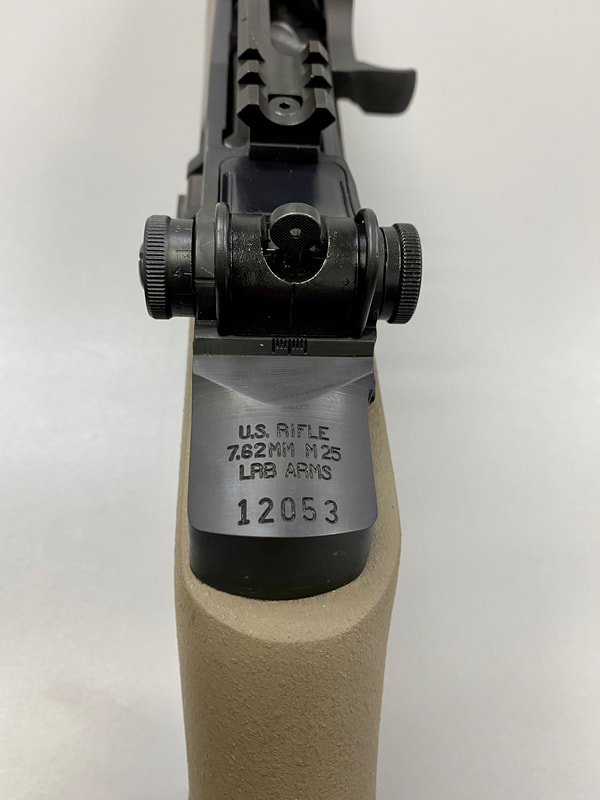
Delays in manufacture forced units to continue use of other established weapons while the M14 increased its circulation reach within the American military inventory. Its particular period of introduction meant that the system was much too late to see service in the Korean War but played a major role in the Vietnam War (1955-1975). In all, about 1.5 million units of the M14 were produced by Springfield Armory during a period spanning from 1959 to 1964. When adopted into American service, the M14 was intended to replace the M1 Garand itself, the M1 Carbine, the M3 Grease Gun submachine gun, and the Browning M1918 BAR light automatic rifles - these weapons having served throughout World War 2 and the Korean War (1950-1953). Thousands of M14s were converted to this form and thrived in service until replaced by the M24 during 1988. This model mated specially-selected M14 bodies to telescopic sighting devices for precision fire, providing an effective range out over 875 yards. In time, a folding stock variant was revealed to help promote a more compact travel profile and a specialized sniper weapon system appeared through the "M21" mark. The full-automatic fire function generated also tended to generate intense heat at the barrel, the barrel not being made easily changeable as it would be in a light machine gun. In practice, the M14 proved itself as a functional semi-automatic rifle - its full-automatic feature was seldom used, both to help preserve ammunition and also due to the inherent lack of control of the weapon when under full-automatic fire.
#Lrb m14 ammo choice upgrade
The 20-round magazine was a considerable upgrade from the limited 8-round capacity of the Garand. Key to the M14's function was a semi-automatic and full-automatic firing selector making the rifle the first American weapon to feature this "dual-mode" function since the days of the World War 1-era Browning M1918 "BAR". Rate-of-fire reached between 700- and 750-rounds per minute with a muzzle velocity of 2,800 feet per second and an effective firing range out to 500 yards. Internally, the action remained the same as in the Garand - gas-operated with a rotating bolt. Instead of the Garand's 8-round, clip-fed system, a more modern 20-round detachable box magazine was used - the magazine inserted under the receiver through a well located just ahead of the trigger. An adjustable rear aperture and front "barleycorn" sight were used in training the weapon down range.

The gas cylinder ran under the barrel with the barrel capped by a slotted compensator. The trigger unit was underslung in the usual way and over the barrel was fitted a ribbed heatshield. Indeed, the M14 retained the long-running, heavyweight stock of the former design with its integrated shoulder and pistol grip sections as well as the forend running under the barrel assembly. Given this pedigree, the M14 was no doubt built upon a stellar foundation. Total production ended with about 6.2 million units entering circulation. The weapon was chambered for the U.S.30-06 Springfield cartridge and fired from a gas-operated, rotating bolt action, going on to become one of the best - if not THE best - service rifles of World War 2. The weapon proved hefty for a service rifle at about 11.5lbs (depending on version in use) and was limited to an 8-round, clip-fed function (though this proved much more useful than bolt-action rifles of the period being limited to three or five rounds and operated manually). Multiple manufacturers contributed to the millions of rifles produced including the legendary Springfield Armory of the United States.

The M1 Garand served as the standard-issue service rifle of the United States Army from 1936 to 1957 and was used from World War 2 through to the Iran-Iraq War (1980-1988) by various parties around the globe. Design work on the new rifle began in 1954. The new weapon became the Springfield "M14" which was more or less a highly modernized M1 Garand rifle of World War 2 (1939-1945) fame.

Instead of opting for a capable, existing foreign design, it proved favorable to take on a locally-designed and produced American automatic rifle. The M14 was brought about to fulfill an American military requirement for a new standard issue service rifle due to the acceptance of the 7.62x51mm NATO (.308 Winchester) cartridge by both the United States and its NATO allies.


 0 kommentar(er)
0 kommentar(er)
